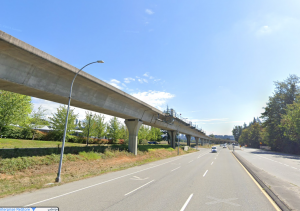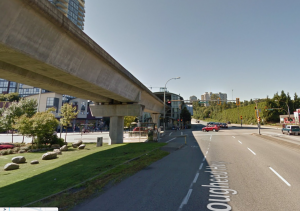As of 2024 the Auckland Light Rail proposal has died. What started as a cheap surface light rail running down the centre of roads became a largely underground system and the cost spiral to at least $15 billion.
In this post I will outline why I think that medium-distance high-traffic routes should instead be built using Automated Light Metro technology.
In a followup post I will suggest a possible 2 line backbone for Auckland. Combining Light Metro with the existing heavy-rail system, some street-running light rail and buses this could be a system which could be built for less than the cost of the governments light-rail proposals and leave lots of room to be extended
Much as motorway project are planned years in advance this could be something that is largely designed and ready to be built when funding and political will are both available.
What is Automated Light Metro?
Automated Light Metro is what Wikipedia classifies as a Medium-capacity rail system , it has greater capacity than light rail but less than a Full Metro System.
For this article will be based the Hitachi Rail Italy Driverless Metro but there are similar systems from other vendors. The Hitachi Rail Italy Driverless Metro system is deployed in several metros including Copenhagen, Brescia, Milan and Taipei.

The main characteristics of the system are:
- Automated (Driverless) Operation
- Grade Separated – Mainly overhead
- Short trains ( 30 – 100m )
- Trains up to every few minutes (or less).
- Large capacity of passengers per hour
- Platform Screen Doors
- Off the shelf Solution
Automated Operation
An important part of the system is that the trains are driverless. Only around 4 people in a control room are needed to run a whole system (which could be 100 trains). Automated operation allows trains to be scheduled close together and also makes it cheap to run lots of trains even off-peak. A train every 10 minutes at 1am for instance.
Grade Separation – Overhead vs Underground
Grade Separation means that there are no crossings of the track. It either runs underground or overhead. This means the track can’t be blocked and is basically required for automated operation.
I’m advocating that lines should be overhead whenever possible. The main advantage of this is lower cost (a third to a half of underground), speed of construction and in some cases easier access to stations.
While some people don’t like the look of overhead lines these will be running on existing motorway or road corridors. Spending billions to put the lines underground is a waste of money that can be used to build more tracks (or result in nothing being constructed at all due to cost)
I think people who worry about the look of overhead rail forget how ugly 4-5 lanes of car-filled roads really are. Not to mention the noise and fumes.


Compare these shots of the Vancouver Skytrain running alongside roads.


Some underground track will probably be required for the CBD but in light of the high extra cost it should be minimised.
Short Trains
Compared to the existing Auckland trains the Light Metro cars are around half the length. This means a 4-car Light Metro train is around 52m vs 145m for a 6 car NZ AM Class train. However the denser loading and greater frequency means that the capacity is around the same.
The shorter Light Metro trains allow for smaller and cheaper stations. Platforms can be smaller and lifts and stairs can be sized for smaller “waves” of passengers.
Very Frequent Trains
Automated Light Metro Systems can have very short intervals (headway) between trains. 90 seconds is available off-the-shelf which allows 40 trains/hour in each direction. This means that passengers are not sitting around waiting for trains, you don’t even have to time when you turn up. See the video below for an example of what 90 seconds between trains feels like.
Because the trains are automated the cost of running trains half as long and twice as often is about the same. Whereas with conventional trains you need another driver and better training for the driver to handle tighter tolerances.
High Capacity
As stated above an Automated Light Metro can typically handle a train every 90 seconds or 40 trains per hour. A system like Hitachi Rail Italy Driverless Metro consists of 13m cars that can carry up to 100 people each (1/3 seated). These can be arranged in 2,3,4 or 6 car trains.
| Headway / Trains per Hour | 2 Cars | 3 Cars | 4 Cars | 6 Cars |
| 5 min / 12 tph | 2,400 | 3,600 | 4,800 | 7,200 |
| 3 min / 20 tph | 4,000 | 6,000 | 8,000 | 12,000 |
| 2 min / 30 tph | 6,000 | 9,000 | 12,000 | 18,000 |
| 90 sec / 40 tph | 8,000 | 12,000 | 16,000 | 24,000 |
I would suggest the system be designed for 4 car trains ( 52m ) giving a maximum capacity of 400 people per train and 16,000 people per hour in each direction. That capacity would probably not be needed initially. So at the start 2 or 3 car trains could be run. Capacity can be increased by more frequent intervals and eventually longer trains.
Stations (especially the underground ones) should be even future-proofed to be upgradable to 6-car trains. But probably upgrade will be decades away. This means that relatively small and cheap stations can be built.
16,000 people/hour is equivalent to 10 lanes of cars, plus another 10 in the other direction. It exceeds the total number of people going South over the Auckland Harbour Bridge during the morning peak ( around 4500/h in buses and 9000/h in cars according to this article )
As a comparison the 66m Light Rail vehicles proposed for Dominion Road would be able to do around 8400 passengers per hour at a 3 minute headway. This would probably be the maximum for a street running system.
Platform Screen Doors
These are standard for all modern systems for safety.
Off the shelf Solution
A system such as Hitachi Rail Italy Driverless Metro is very much an industry standard. The system is operating successfully in several other cities around the world. This is much lower risk than going with a bespoke solution or unusual technology.
How does it compare to other options?
Advantages of Light Metro over Light Rail
The main advantage of Light Metro over Light Rail is capacity. While a basic street-running light rail is cheaper increasing that capacity beyond a certain point results in very long trains, cross roads being blocked and if full grade separation is introduced a big increase in cost to around what Light Metro would be.
Light Metro is also faster (see next section) and since it is a completed separated less prone to disruption.
However street-running light rail is cheaper and better suited for some routes that do not require high-capacity or speed and which have frequent stops. So routes covering local trips around Queen Street, Ponsonby and Parnell would be better suited to Light Rail.
Speed estimate
The Copenhagen Metro has an average speed (including stops) of 40km/h. This would point to a journey time of around 30 minutes from Westgate, The Airport or Albany to the CBD. The maximum speed is 80km/h so means that long sections could be practical. For example an 13km extension between Albany and Silverdale would take 10 minutes.
Partially Separated Light Rail usually averages at best than 30km/h and less than that in sections with many stops and/or crossings.
Relationship with exist Heavy rail
Light Metro will be to a different standard to the existing rail system. This is not a disadvantage since it will run on completely separate and new lines. The existing lines (including the CRL) are already at capacity in trains/hour so new lines will always be needed.
A system that is designed to be compatible with existing rail will probably unable to be automated and would have many other compromises.
More information.
Greater Auckland has pushed several articles about Light Metro previously
- Making a Fair Light Rail/Metro Comparison – May 2021
- Light rail and light metro, why not both? – Nov 2020
- If Light Metro is the answer? – Nov 2019
- Light metro for the North Shore: a superior alternative to a harbour motorway tunnel? – Jan 2012
- Driverless Light-Metro: The Dominion Line – Jun 2012
- ART Light Metro: An affordable solution for new rapid transit in Auckland? – Oct 2011